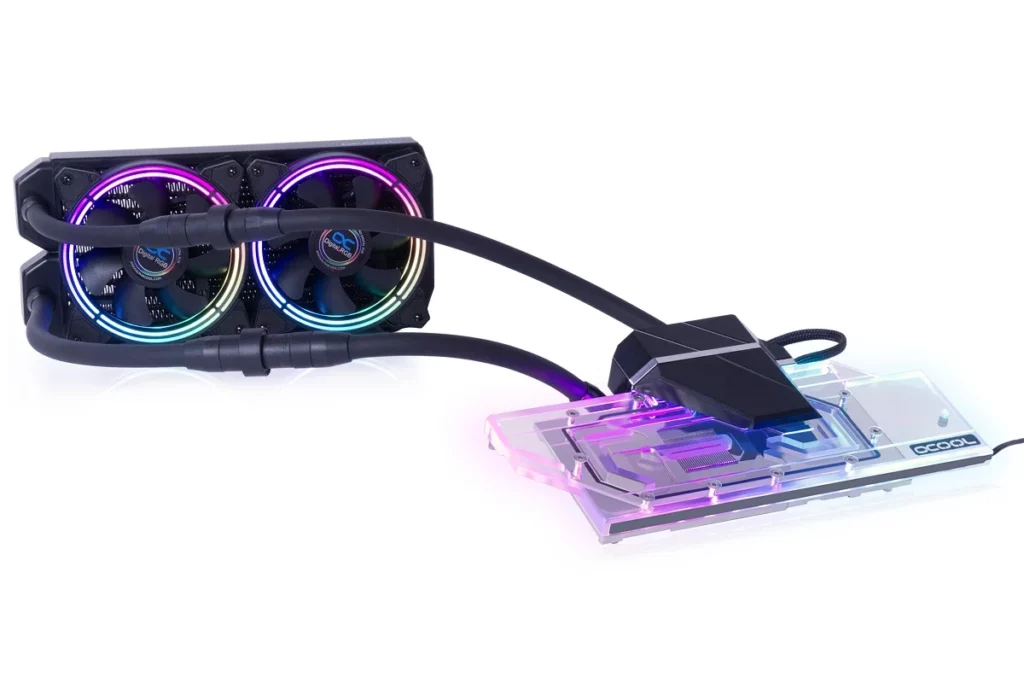Is AIO GPU worth it? Here’s a detailed blog post about whether AIO GPUs are worth your investment
AIO (All-in-One) liquid coolers have become a popular solution for keeping CPUs cool, but what about GPUs?
AIO GPUs feature a similar design – a pre-filled, closed-loop liquid cooling system designed to efficiently manage the heat generated by powerful graphics cards.
Let’s dive into the advantages and potential drawbacks to help you decide if an AIO GPU aligns with your needs.
What is an AIO GPU?

An AIO GPU incorporates a water block (which sits directly on the GPU chip), a pump for circulating coolant, a radiator to dissipate heat, and flexible tubing. This system offers a pre-assembled, maintenance-free solution for liquid cooling your graphics card.
Advantages of AIO GPUs
- Enhanced Cooling Performance: AIOs typically outperform traditional air-cooled GPUs, offering lower temperatures and reducing the potential for thermal throttling (where the GPU slows down to protect itself).
- Reduced Noise Levels: Liquid cooling often leads to quieter operation compared to the fans on air-cooled GPUs, especially under heavy loads.
- Overclocking Potential: With lower temperatures, AIO GPUs provide more headroom for overclocking, allowing you to push your graphics card to higher performance levels.
- Aesthetics: Some AIO GPUs come with eye-catching designs, including RGB lighting, adding a visual flair to your computer build.
Disadvantages of AIO GPUs
- Cost: AIO GPUs are generally more expensive than air-cooled counterparts.
- Complexity: Installing an AIO GPU can be slightly more involved than standard air coolers, requiring careful placement of the radiator.
- Space Considerations: The radiator and tubing take up additional space within your computer case, so ensure compatibility.
- Potential for Leaks (Rare): While rare, AIO systems carry a small risk of leaks, though many modern units have robust safeguards.
When is an AIO GPU Worthwhile?
- Enthusiast Builds: For those pushing the limits of their hardware with overclocking or running demanding applications, an AIO GPU can offer the temperature control to support higher performance.
- Space-Constrained Cases: If you have a smaller case with limited airflow, an AIO GPU can help manage heat more efficiently.
- Noise Sensitivity: If operating noise is a major concern, an AIO GPU can significantly reduce the hum compared to some air-cooled models.
- Pushing for Peak Performance: If you want the absolute best performance from your GPU, an AIO can help maintain that peak for longer without thermal limitations.
When Might an AIO GPU Not Be the Best Choice?
- Budget Builds: Air coolers deliver excellent value, so if cost-effectiveness is your primary goal, a high-quality air cooler might be a better fit.
- Limited Expertise: If you’re not very comfortable with hardware installation and handling liquids, going with a traditional air cooler might be less stressful.
- Unnecessary Overkill: If your GPU doesn’t generate excessive heat or you don’t plan to overclock aggressively, air cooling could be perfectly sufficient.
Things to Consider
- Compatibility: Always check that the AIO GPU is compatible with your specific graphics card model and has adequate clearance within your case.
- Radiator Size: AIOs come with different radiator sizes (often 120mm, 240mm, etc.) Larger radiators offer better heat dissipation but need more mounting space.
- Brand Reputation: Opt for reputable brands when choosing an AIO GPU to ensure quality construction and minimize the risk of leaks.
The Verdict: Is an AIO GPU Worth It?
An AIO GPU isn’t strictly necessary for most PC builds, but it offers potential advantages in terms of performance, noise, thermal headroom, and even aesthetics. If you have the budget, prioritize performance, and want to ensure your GPU stays cool and quiet, an AIO GPU can be a worthwhile upgrade.
Read also: